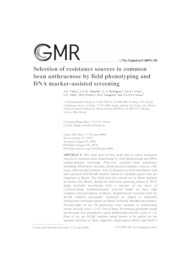Selection of resistance sources to common bean anthracnose by field phenotyping and DNA marker-assisted screening.
Selection of resistance sources to common bean anthracnose by field phenotyping and DNA marker-assisted screening.
Summary: The main goal of this work was to select resistance sources to common bean anthracnose by field phenotyping and DNA marker-assisted screening. Fifty-five common bean genotypes, including differential varieties, characterized resistance sources, elite lines, cultivars and controls, were evaluated in a field inoculation trial and screened with SCAR markers linked to resistance genes that are important in Brazil. The field trial was carried out in Santo Antônio de Goiás, GO, Brazil, during the fall/winter growing season of 2014, using artificial inoculation with a mixture of six races of Colletotrichum lindemuthianum, selected based on their high virulence and prevalence in Brazil. Amplification reactions with the SCAR markers previously identified as linked to important anthracnose resistance genes on Brazil followed standard procedures. Twenty-eight of the 58 genotypes were resistant to anthracnose (mean severity score ≤ 3.5). Ten of these 28 resistant genotypes stood out because they presented a mean anthracnose severity score of 1.0. Four of the six SCAR markers tested shown to be useful for the assisted selection of their respective target genes (SH18 and SAS13 for Co-42, SAB03 for Co-5, and SAZ20 for Co-6). Two carioca seeded elite lines were highlighted by the phenotypic and molecular screening: K10 (Co-34, Co-42, Co-5 and Co-6) and K13 (Co-4²). The phenotypic and molecular characterization of candidate resistance sources to common bean anthracnose based on their disease reaction in field inoculation trials and on the analysis with molecular markers linked to resistance genes has shown to be a useful strategy. These results aid in the selection of donor parents and resistant lines to be preferably explored by common bean breeding programs in Brazil.
Publication year: 2018
Types of publication: Journal article
Unit: Embrapa Rice & Beans
Observation
Some of Embrapa's publications are published as ePub files. To read them, use or download one of the following free software options to your computer or mobile device. Android: Google Play Books; IOS: iBooks; Windows and Linux: Calibre.
Access other publications
Access the Agricultural Research Database (BDPA) to consult Embrapa's full library collection and records.
Visit Embrapa Bookstore to purchase books and other publications sold by Embrapa.

